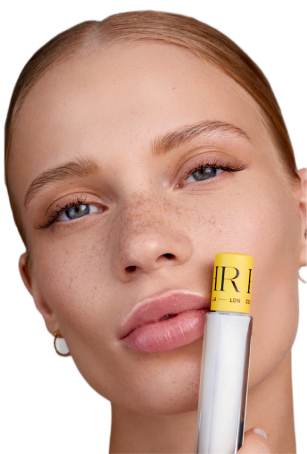The fragrance problem
We have a love affair with fragrance, with wisps of peony, iris and gardenia enveloping us in rich, romantic and dewy aromas, we are all addicted to the floral, heady scents of beauty. Unfortunately, there is more to it than meets the eyes (or nose) behind the label of 'fragrance', and sadly it's not rose petals. As we unravel yet another layer of the toxic side of beauty, it so happens that fragrance is the dirtiest word in the industry and we are covered in it. Brushing off the lavender petals and vanilla pods that perfume our favourite products, there lies a much darker scent. Your average bottle of perfume, your scented moisturiser or your favourite lipstick contains an unidentified concoction of ingredients. With one fell swoosh of fragrance, beauty lovers are bombarded with hundreds of chemicals, and that's just the perfume alone.
Through synthetic or natural ingredients, scent can transport us from a romantic love story to a soft essence of well-being. Fragrance can be soul-enriching for our olfactory senses. Consumer research suggests that the sweet earthy aromas in products easily persuade us into buying more. As fragrance conjures the feelings of luxury, it comes as no surprise that brands splash perfume into more products than you can imagine. But the word 'fragrance' in a beauty products ingredients list is like a black hole of chemicals.
Ingredients in perfume can derive from materials such as petroleum and petrochemicals and found from shower gels to lipsticks. Scent is added to cosmetics to mask the unpleasant smell of chemicals that make up the product. The beauty industry knows the power of an alluring and irresistible fragrance. Even when products are labelled 'fragrance-free', they have just enough scent to mask the displeasing smell of the original product.
As our favourite perfume allows us to flutter between the Amalfi coast or the soothing aromas of our favourite spa, consumers are having the wool pulled over their eyes. Companies by law do not have to disclose the full ingredients list in fragrance to preserve 'trade secrets', creating this exploited loophole. Scent gets a free pass on labels and is the only component that can hide under a cloud of citrus and woody aromas. Despite a blend of hundreds of chemicals mixed into just one perfume, labels in the US and EU will only list them as 'fragrance' or 'parfum'. In the EU, there is an exception of 26 ingredients that must be declared, and only 20 that are banned. Yet the American Academy of Dermatology (AAD) says there is a potential of 4000 fragrance molecules that are in rotation within the perfume industry. And as our cosmetic labels look more like a chemistry exam, it can feel impossible to decipher what's really in our beloved lipsticks.
This label-listing loophole allows potentially harmful chemicals to slip through the net and onto unknowing consumers. Studies have shown a third of these 4000 ingredients are allergens and endocrine disruptors. It seems notes of chemicals amplify our rose petal and jasmine perfumes. Even more worryingly the industry relies on the International Fragrance Association (IFRA) and the Research Institute for Fragrance Materials (RIFM) to identify ingredients used in perfume, essentially the fragrance industry self-regulates. This means that safety testing does not have to be approved by regulators before products hit the market. It's troubling that one word on our list' fragrance' can mean a cocktail of hundreds of toxic ingredients.
As we garner more scientific interest in the beauty-world, it becomes painfully evident at the number of chemicals that are exposed to consumers daily, and fragrance is yet another polluting beauty obsession.
While we live in a scented world, consumers are unaware of what they routinely swipe on their faces and body. Research suggests that fragrance chemicals are linked to serious health issues, from cancer to reproductive toxicity, asthma, carcinogens, allergies and even endocrine disruption, the list seems endless. Fragrance is one of the most common causes of adverse skin reactions, and these reactions can be invisible to the naked eye. The AAD report that scent is one of the biggest causes of cosmetic contact dermatitis, similar to poison ivy and nickel! Doctors are finding synthetic perfumes as far as human tissue and breast milk, and 35% of people report migraines and respiratory problems due to fragrance. And as a single perfume could contain up to 300 chemicals, these molecules of scent are more dangerous than we know, it might just be that smelling good could cost us our health.
The lack of transparency in the perfume industry can make it challenging to avoid chemicals when they hide behind the word 'fragrance'. These toxic cocktails can cause an onslaught of damaging effects on the body, and these chemicals are essential to know. Look out for Benzophenone; this chemical is linked to endocrine disruption and system toxicity. Acetaldehyde is another chemical to look out for; this can affect kidneys and respiratory systems and phthalates, which are known to disrupt hormones, cause reproductive malformation and is linked to breast and liver cancer.
The Research for Women's Voices for the Earth (WVE) reports that 1,200 chemicals used in fragrance are potential or known 'chemicals of concern', including seven carcinogens and 15 chemicals prohibited from use in cosmetics within the EU. More worryingly, scent is thought to be an endocrine disruptor, mimicking human hormones which can lead to developmental, reproductive, brain and immune problems.
And don’t be fooled by the term 'natural' fragrance as there are no standard criteria for what this means. In cases of where essential oils are used, these can cause allergic reactions and contact dermatitis. Clean beauty standards allow 1% of fragrance to be used in products. If a component has to be reduced and regulated to deem 'natural', then it doesn't seem clean at all. And when we combine toxic fragrance with the other daily concoction of chemicals we are exposed to, this heady essence of perfume is one thing we suggest you avoid.
At HIGHR, we understand fragrance is ubiquitous, soul-enriching and an essential aspect of creating the sensory experience of beauty. Yet beauty is never worth exposing ourselves to toxins for, we recommend being conscious of the fragrance you put on your body. While it’s unrealistic to suggest you switch all your products out for cleaner versions, we do suggest taking more care when it comes to certain categories that make us more vulnerable to chemicals like those in fragrance. Try looking for cleaner options for your lip and skincare products and start there. We’ve chosen to start our business by formulating lip products because it is the only category that you actually ingest.
At HIGHR, we've chosen to use organic food-grade flavour instead of fragrance or essential oils for our lipsticks, specifically organic watermelon and organic flat-leaved vanilla. If it's good enough to eat, it's safe enough to swipe on.
This is clean beauty, but HIGHR.
- Esme Bourne


